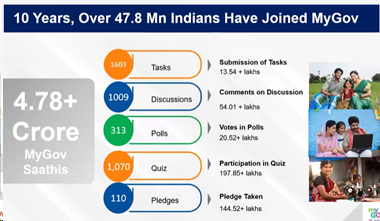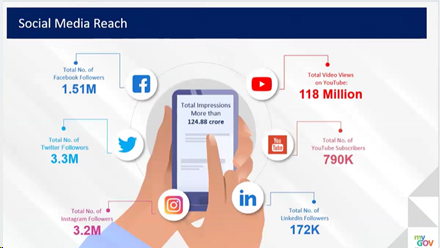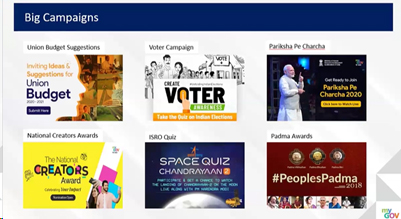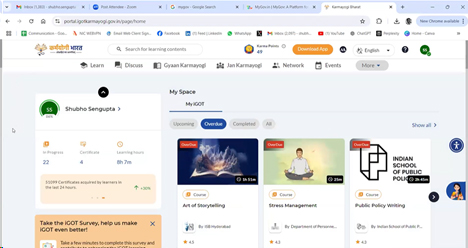An evening with Mr Shubho Sengupta
Introduction
On Friday, August 23, we had an interesting session by Mr. Shubho Sengupta, a seasoned digital marketer with an extensive background in advertising. Mr Sengupta is a storyteller and a strategist who knows the art of blending creativity with technology. During the session, he shared his insights on how governments build meaningful conversations with citizens. In particular, he talked about the citizen engagement portal, MyGov.com and the government’s elearning portal, Karmayogi Bharat.
About Mr. Shubho Sengupta
Mr. Shubho Sengupta’s career spans nearly three decades. He has worked with leading global agencies such as Ogilvy, JWT, and Leo Burnett, where he shaped impactful campaigns for brands like Coca-Cola, Pepsi, NIIT, and Motorola. Mr. Sengupta played a crucial role in establishing digital best practices for Coca-Cola and setting up the renowned Coke Studio India.
Mr. Sengupta has been with the government for the past 6 years or so. In his current role as Head of Communications & UI/UX at Karmayogi Bharat, Mr. Sengupta contributes to the Government of India's capacity-building platform for officials. He previously held leadership roles at MyGov India, driving citizen engagement initiatives and creative strategies for the world's largest civic engagement platform.
An entrepreneur at heart, in the past, Mr. Sengupta has co-founded two successful startups—Pinkshastra in healthcare and StudioActiv in activewear. Additionally, his consulting work with major brands like Tata Tea and Mahindra has focused on aligning digital strategies with brand objectives.
Mr. Sengupta's journey reflects his deep passion for working at the intersection of technology and culture, thereby bringing stories to life. He is also a national columnist, art curator, and the first Indian to cycle solo in Ladakh.
About MyGov
MyGov is India’s Citizen Engagement Platform that empowers people to connect with the Government and contribute towards good governance. MyGov collaborates with multiple Government bodies/ Ministries to engage with citizens for policy formulation and seeks the opinion of people on issues/ topics of public interest and welfare. There are polls, blogs, podcasts, quizzes, pledges, etc. About 50-60 videos are created every day.

Here is the main agenda for MyGov.
- Simplify and communicate schemes/initiatives of the government.
- Two-way engagement with digital citizens in their language.
- Collect citizen ideas, opinions.
- Use of data, infographics, videos, podcasts.
- Fight fake news with real time info (e.g., Covid).
- Leverage all social media platforms and channels.
- Collaborate, co-create with national/regional influencers.
- Build capacity and capability for states.
- Enable robust outreach through 'Ambassador Program.
- Integrate latest technologies (e.g. virtual helpdesks).
Since its launch on 26th July 2014, MyGov has onboarded more than 30 million registered users. Almost all government departments leverage MyGov platform for their citizen engagement activities, consultations for policy formulation and to disseminate information to citizens for various Government schemes and programs. MyGov is amongst the most active profiles on Social Media – Twitter, Facebook, Instagram, YouTube and LinkedIn. MyGov also has a significant presence on several Indian social media platforms like Koo, Sharechat, Chingari, Roposo, Bolo Indya and Mitron. MyGov has adopted multiple engagement methodologies like discussions, tasks, polls, surveys, blogs, talks, pledges, quizzes and on-ground activities by innovatively using internet, mobile apps, IVRS, SMS and outbound dialling (OBD) technologies. MyGov has also launched instances in 23 States.

Logos and taglines of key national projects have been crowdsourced through MyGov. A few notable examples include the logos for Swachh Bharat, National Education Policy and Digital India Campaign.

MyGov has also solicited inputs of draft policies from citizens. Examples are National Education Policy, Data Centre Policy, Data Protection Policy, National Ports Policy, IIM Bill, National Youth Policy, etc. MyGov has also been frequently soliciting ideas for Mann Ki Baat, Annual Budget, Pariksha Pe Charcha and other important initiatives. Many government campaigns are covered by MyGov:
https://www.mygov.in/campaigns/

Covid 19
During COVID19, MyGov supported the Ministry of Health and Family Welfare to disseminate authentic, easy to understand and consistent information. To drive behavioral change, fight fake news and bust myths, MyGov created a dedicated portal for COVID related information dissemination – https://www.mygov.in/covid-19. MyGov also built a Chatbot on WhatsApp to disseminate information about Covid19 and vaccination through a Helpdesk number.
During the Q&A, Mr. Sengupta mentioned that the Arogya Setu app was launched in just a few days, pooling expertise from industry professionals and experts. Celebrities (like Amitabh Bachchan and Sharukh Khan) and volunteers were used to keep the public interest alive. The CoWIN app was also launched quite quickly
About Karmayogi Bharat
https://karmayogibharat.gov.in/
Karmayogi Bharat has been set up to build capacity in the Indian civil services. It has established a robust digital ecosystem enabling continuous anytime-anywhere learning to make the officials future ready. It provides an all-in-one online platform for civil service officials. It guides learning, hosts discussions, manages careers, and conducts reliable assessments to showcase officials' competency effectively. While the site provides education, the ultimate objective is to drive behavioral change.
Some 45 lakh people are already enrolled on the portal which has over 1000 courses: domain, behavioral and functional. Unlike Coursera and other MOOCs platforms, where learners choose the courses, in Karmayogi, algorithms are used to recommend courses to the learners depending on their specific needs. Each officer has a customized learning plan. Based on the learning, karma points are awarded. These points play an important role in promotions, lateral movements and transfers. Many experts and celebrities from all over the world from academics, industry and government are active participants on the platform.

Within the portal, there are two types of knowledge. Gyaan Karmayogi is a knowledge library. It has documents on a range of important topics. Jan Karmayogi provides details of the various schemes run by the government. All the data needed by the government officers is readily available.
The AI tool, Bashini will enable the translation to other Indian languages.
Q&A
Mr. Sengupta made the transition to government after working in the private sector for several years. He feels that when working for the government, the impact is more visible and immediate. We can make out how people’s lives are being changed. In the case of corporate brands, the impact takes time. Changing people’s lives is intrinsically more satisfying than selling brands. Moreover, the scale at which the government operates is incredible.
The government had already put in place a strong digital infrastructure. So Mr. Sengupta sensed an opportunity to see how digital works on the ground.
While answering another question, Mr. Sengupta added that it is a misnomer that the government is always very slow. Sometimes in the private sector, layers of approval are involved even for high priority projects.
Mr. Sengupta explained that with the help of India’s network of District Collectors, District Magistrates, Police and volunteers on the ground, it is possible for the government to reach out to the common citizens rapidly during times of crises.
In general, impact measurement is not easy, especially short-term impact. Even in the case of learning interventions, the final impact must be not on the government officers but on the citizens. In the case of Karmayogi, there are agencies to conduct various surveys. In the case of MyGov, the main idea is to promote citizen engagement. However, NITI Aayog has elaborate mechanisms for collecting large volumes of data in real time and using the latest and sensitive measurement devices and systems to measure the impact of different schemes and campaigns.
